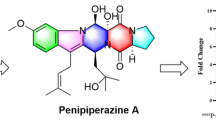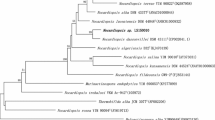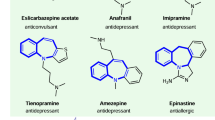Abstract
A new azepino-diindole alkaloid; rhodozepinone (1), along with five known compounds, including 2-amino-3-[2(1H)-quinolinon-4-yl]propionic acid (2), 3-hydroxy-2-methyl-4H-pyran-4-one (maltol) (3), phenyl acetic acid methyl ester (4), indole-3-acetic acid (5), and 2-amino-3-(1H-indol-3-yl) propanoic acid (tryptophan) (6) were isolated and identified from the broth culture of Rhodococcus sp. UA13, which had been previously recovered from the Red Sea sponge Callyspongia aff. Implexa. The structures of compounds (1–6) were determined by spectroscopic analyses, including 1D and 2D NMR experiments in combination with HR-ESI-MS, as well as comparison with the literature. All the characterized metabolites were firstly reported herein from this marine sponge-associated actinomycete, and among them, (3), (4), and (6) were characterized for the first time from the genus Rhodococcus, whereas this is the first report for isolation of compound (2) from a natural source. Moreover, both the antimicrobial and antitrypanosomal properties of the isolated metabolites (1–6) were evaluated, and only rhodozepinone (1) exhibited significant antibacterial and antitrypanosomal activities against Staphylococcus aureus NCTC 8325 (IC50 = 8.9 µg/ml) and Trypanosoma brucei brucei TC221 [IC50 = 16.3 (48 h) and 11.8 (72 h) µg/ml], respectively. These results totally reflected the potential of sponge-derived actinomycetes as a rich source of new natural products with interesting bioactivities, as well as their promising future contribution to drug discovery.


Similar content being viewed by others
Change history
30 November 2018
The authors have retracted this article due to the inconsistencies between the reported structures of compounds 1 and 2 and their NMR experimental data. All authors agree with this retraction.
30 November 2018
The authors have retracted this article due to the inconsistencies between the reported structures of compounds 1 and 2 and their NMR experimental data. All authors agree with this retraction.
References
Abdelmohsen UR, Balasubramanian S, Oelschlaeger TA, Grkovic T, Pham NB, Quinn RJ, Hentschel U (2017) Potential of marine natural products against drug-resistant fungal, viral, and parasitic infections. Lancet Infect Dis 17:e30–e41
Abdelmohsen UR, Bayer K, Hentschel U (2014) Diversity, abundance and natural products of marine sponge-associated actinomycetes. Nat Prod Rep 31:381–399
Abdelmohsen UR, Pimentel-Elardo SM, Hanora A, Radwan M, Abou-El-Ela SH, Ahmed S, Hentschel U (2010) Isolation, phylogenetic analysis and anti-infective activity screening of marine sponge-associated actinomycetes. Mar Drugs 8:399–412
Abdelmohsen UR, Szesny M, Othman EM, Schirmeister T, Grond S, Stopper H, Hentschel U (2012) Antioxidant and anti-protease activities of diazepinomicin from the sponge-associated Micromonospora strain RV115. Mar Drugs 10:2208–2221
Andayani DS, Sukandar E, Adnyani K (2014) Isolation, identification of phenyl acetic acid from Streptomyces galbus TP2 strain and its toxicity. Int. J Pharm Pharm Sci 6:643–646
Ashelford KE, Chuzhanova NA, Fry JC, Jones AJ, Weightman AJ (2006) At least 1 in 20 16S rRNA sequence records currently held in public repositories is estimated to contain substantial anomalies. Appl Environ Microbiol 71:7724–7736
Cheng C, Othman EM, Reimer A, Grune M, Kozjak-Pavlovic V, Stopper H, Hentschel U, Abdelmohsen UR (2016) Ageloline, A new antioxidant and antichlamydial quinolone from the marine sponge-derived bacterium Streptomyces sp SBT345. Tetrahedron Lett 57:2786–2789
de Candia M, Zaetta G, Denora N, Tricarico D, Majellaro M, Cellamare S, Altomare CD (2017) New azepino[4,3-b]indole derivatives as nanomolar selective inhibitors of human butyrylcholinesterase showing protective effects against NMDA-induced neurotoxicity. Eur J Med Chem 125:288–298
Eltamany EE, Abdelmohsen UR, Ibrahim AK, Hassanean HA, Hentschel U, Ahmed SA (2014) A new antibacterial xanthone from the marine sponge-derived Micrococcus sp. EG45. Bioorg Med Chem Lett 24:4939–4942
Evidente A, Iacobellis NS, Sisto A (1993) Isolation of indole-3-acetic acid methyl ester, a metabolite of indole-3-acetic acid from Pseudomonas amygdali. Experientia 49:182–183
Grkovic T, Abdelmohsen UR, Othman EM, Stopper H, Edrada-Ebel R, Hentschel U, Quinn RJ (2014) Two new antioxidant actinosporin analogs from the calcium alginate beads culture of sponge-associated Actinokineospora sp. strain EG49. Bioorg Med Chem Lett 24:5089–5092
Hentschel U, Schmid M, Wagner M, Fieseler L, Gernert C, Hacker J (2001) Isolation and phylogenetic analysis of bacteria with antimicrobial activities from the mediterranean sponges Aplysina aerophoba and Aplysina cavernicola. FEMS Microbiol Ecol 35:305–312
Holland J, Gooding D, Chorlton A (2014) Novel rebamipide complexes and cocrystals. US Patent 20140039005 A1, filled February 24, 2012, issued February 24, 2014
Huber W, Koella JC (1993) A comparison of three methods of estimating ec50 in studies of drug resistance of malaria parasites. Acta Trop 55:257–261
Ibrahim MA, Aliyu AB, Abdullahi H, Solomon T, Toko E, Garba A, Bashir M, Habila N (2013) Lactone-rich fraction from Vernonia blumeoides: antitrypanosomal activity and alleviation of the parasite-induced anemia and organ damage. J Nat Med 67:750–757
Inderlied CB, Salfinger M (1995) Antimicrobial agents and susceptibility tests: Mycobacteria. In: Murray PR, Baron EJ, Pfaller MA, Tenover FC, Yolken RH (ed) Manual of clinical microbiology, 6th ed. American Society for Microbiology, Washington DC, p 1385–1404
Jacobs RT, Nare B, Phillips MA (2011) State of the art in African trypanosome drug discovery. Curr Top Med Chem 11:1255–1274
Kali A (2015) Antibiotics and bioactive natural products in treatment of methicillin resistant Staphylococcus aureus: a brief review. Pharmacogn Rev 9:29–34
Kim J (2009) Understanding the evolution of methicillin-resistant Staphylococcus aureus. Clin Microbiol Newsl 31:17–23
Kornsakulkarn J, Saepua S, Supothina S, Chanthaket R, Thongpanchang C (2014) Sporaridin and sporazepin from actinomycete Streptosporangium sp. BCC 24625. Phytochem Lett 10:149–151
Lam KS (2006) Discovery of novel metabolites from marine actinomycetes. Curr Opin Microbiol 9:245–251
Lane DJ (1991) 16S/23S rRNA sequencing. In: Stackebrandt E, Goodfellow M (ed) Nucleic acid techniques in bacterial systematic. Wiley, Chichester, p 115–175
Lechevalier MP (1975) Actinomycetes of sewage-treatment plants. Environ Prot Technol Ser EPA–600/2–75–031
Lee JH, Kim YG, Kim CJ, Lee JC, Cho MH, Lee J (2012) Indole-3-acetaldehyde from Rhodococcus sp. BFI 332 inhibits Escherichia coli O157:H7 biofilm formation. Appl Microbiol Biotechnol 96:1071–1078
Ludwig W, Strunk O, Westram R, Richter L, Meier H, Yadhukumar, Buchner A, Lai T, Steppi S, Jobb G et al. (2004) ARB: a software environment for sequence data. Nucleic Acid Res 32:1363–1371
Lyman J, Fleming R (1940) Composition of seawater. J Mar Res 3:134–146
Malvy D, Chappuis F (2011) Sleeping sickness. Clin Microbiol Infect 17:986–995
Mincer TJ, Fenical W, Jensen PR (2005) Culture-dependent and culture-independent diversity within the obligate marine actinomycete genus Salinispora. Appl Environ Microbiol 71:7019–7028
Mori T, Aishima T (1992) Specific odor component produced by Mycobacterium lepraemurium on Ogawa yolk medium. Nippon Rai Gakkai Zasshi 61:153–156
Nalli Y, Gupta S, Khajuria V, Singh VP, Sajgotra M, Ahmed Z, Thakur NL, Ali A (2016) TNF-α and IL-6 inhibitory effects of cyclic dipeptides isolated from marine bacteria Streptomyces sp. Med Chem Res 26:93–100
Nawrath T, Mgode GF, Weetjens B, Kaufmann SH, Schulz S (2012) The volatiles of pathogenic and nonpathogenic mycobacteria and related bacteria. Beilstein J Org Chem 8:290–299
Olson JB, Lord CC, McCarthy PG (2000) Improved recoverability of microbial colonies from marine sponge samples. Microb Ecol 40:139–147
Omer ZS, Tombolini R, Broberg A, Gerhardson B (2004) Indole-3-acetic acid production by pink-pigmented facultative methylotrophic bacteria. Plant Growth Regul 43:93–96
Otsubo K, Morita S, Uchida M, Yamasaki K, Kanbe T, Shimizu T (1991) Synthesis and antiulcer activity of optical isomers of 2-(4-Chlorobenzoylamino)-3[2(1H)-quinolinon-4-yl]propionic acid (Rebamipide). Chem Pharm Bull 39:2906–2909
Pan W-B, Chang F-R, Wei L-M, Wu M-J, Wu Y-C (2003) New and efficient method for esterification of carboxylic acids with simple primary and secondary alcohols using cerium (IV) ammonium nitrate (CAN). Tetrahedron Lett 44:331–334
Pine L, Watson SJ (1959) Evaluation of an isolation and maintenance medium for Actinomyces species and related organisms. J Lab Clin Med 54:107–114
Rather SA, Kumar S, Rah B, Arif M, Ali A, Qazi P (2014) A potent cytotoxic metabolite from terrestrial actinomycete, Streptomyces collinus. Med Chem Res 23:382–387
Reasoner DJ, Geldreich EE (1985) A new medium for the enumeration and subculture of bacteria from potable water. Appl Environ Microbiol 49:1–7
Reimer A, Blohm A, Quack T, Grevelding CG, Kozjak-Pavlovic V, Rudel T, Hentschel U, Abdelmohsen UR (2015) Inhibitory activities of the marine streptomycete-derived compound SF2446A2 against Chlamydia trachomatis and Schistosoma mansoni. J Antibiot 68:674–679
Sasaki T, Ohtani II, Tanaka J, Higa T (1999) Iheyamines, new cytotoxic bisindole pigments from a colonial ascidian, Polycitorella sp. Tetrahedron Lett 40:303–306
Sauleau P, Martin MT, Dau ME, Youssef DTA, Bourguet-Kondracki ML (2006) Hyrtiazepine, an azepino-indole-type alkaloid from the Red Sea marine sponge Hyrtios erectus. J Nat Prod 69:1676–1679
Shirling EB, Gottlieb D (1966) Methods for characterization of Streptomyces species. Int J Syst Bacteriol 16:313–340
Steverding D (2010) The development of drugs for treatment of sleeping sickness: a historical review. Parasites Vectors 3:15
Subramani R, Aalbersberg W (2012) Marine actinomycetes: an ongoing source of novel bioactive metabolites. Microbiol Res 167:571–580
Sujatha P, Bapi Raju KV, Ramana T (2005) Studies on a new marine streptomycete BT-408 producing polyketide antibiotic SBR-22 effective against methicillin resistant Staphylococcus aureus. Microbiol Res 160:119–126
Tabares P, Pimentel-Elardo SM, Schirmeister T, Hunig T, Hentschel U (2011) Anti-protease and immunomodulatory activities of bacteria associated with Caribbean sponges. Mar Biotechnol 13:883–892
Taylor MW, Radax R, Steger D, Wagner M (2007) Sponge-associated microorganisms: evolution, ecology, and biotechnological potential. Microbiol Mol Biol Rev 71:295–347
Tong SY, Davis JS, Eichenberger E, Holland TL, Fowler VG (2015) Staphylococcus aureus infections: epidemiology, pathophysiology, clinical manifestations, and management. Clin Microbiol Rev 28:603–661
Tuomi T, Laakso S, Rosenqvist H (1994) Indole-3-acetic acid (Iaa) production by a biofungicide Streptomyces-Griseoviridis strain. Ann Bot Fenn 31:59–63
Wang Q, Garrity GM, Tiedje JM, Cole JR (2007) Naïve Bayesian classifier for rapid assignment of rRNA sequences into the new bacterial taxonomy. Appl Environ Microbiol 73:5261–5267
Wang H, Jenner AM, Lee C-YJ, Shui G, Tang SY, Whiteman M, Wenk MR, Halliwell B (2007) The identification of antioxidants in dark soy sauce. Free Radic Res 41:479–488
Webster NS, Wilson KJ, Blackall LL, Hill RT (2001) Phylogenetic diversity of bacteria associated with the marine sponge Rhopaloeides odorabile. Appl Environ Microbiol 67:434–444
Williams PG, Asolkar RN, Kondratyuk T, Pezzuto JM, Jensen PR, Fenical W (2007) Saliniketals A and B, bicyclic polyketides from the marine actinomycete Salinispora arenicola. J Nat Prod 70:83–88
Wu SJ, Fotso S, Li F, Qin S, Laatsch H (2007) Amorphane sesquiterpenes from a marine Streptomyces sp. J Nat Prod 70:304–306
Xu X-B, Tang F, Guo X-F, Wang J, Yao X, Sun J, Xun H (2015) Isolation, identification and determination of six nucleosides and two amino acids from bamboo shoots of Gramineae Phyllostachys prominens (WY Xiong). Trop J Pharm Res 14:2239–2246
Acknowledgements
The authors are grateful to Dr. Matthias Grüne for the NMR data acquisition. Our thanks also to Antje Fuss/ Prof. August Stich (SFB 630 TP Z1, University of Würzburg) for the antimicrobial and antitrypanosomal assays.
Author information
Authors and Affiliations
Corresponding author
Ethics declarations
Conflict of interest
The authors declare that they have no competing interests.
Additional information
The authors have retracted this article due to the inconsistencies between the reported structures of compounds 1 and 2 and their NMR experimental data. All authors agree with this retraction.
Electronic supplementary material
About this article
Cite this article
Elsayed, Y., Refaat, J., Abdelmohsen, U.R. et al. RETRACTED ARTICLE: Rhodozepinone, a new antitrypanosomal azepino-diindole alkaloid from the marine sponge-derived bacterium Rhodococcus sp. UA13. Med Chem Res 26, 2751–2760 (2017). https://doi.org/10.1007/s00044-017-1974-y
Received:
Accepted:
Published:
Issue Date:
DOI: https://doi.org/10.1007/s00044-017-1974-y




